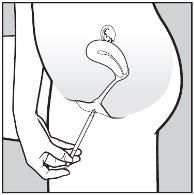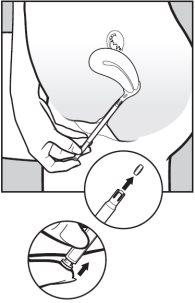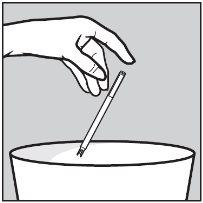

VAGIFEM 10 micrograms VAGINAL COATED TABLETS

Ask a doctor about a prescription for VAGIFEM 10 micrograms VAGINAL COATED TABLETS

How to use VAGIFEM 10 micrograms VAGINAL COATED TABLETS
Introduction
Prospect: information for the user
Vagifem 10 micrograms vaginal tablets
estradiol
Read the entire prospectus carefully before starting to use the medicine, because
it contains important information for you.
- Keep this prospectus, as you may need to read it again.
- If you have any doubts, consult your doctor or pharmacist
- This medicine has been prescribed to you, and you should not give it to others even
if they have the same symptoms as you, as it may harm them.
- If you experience side effects, consult your doctor or pharmacist, even if it is a
side effect not listed in the prospectus. See section 4, "Possible side effects"
Contents of the prospectus
- What is Vagifem and what is it used for
- What you need to know before starting to use Vagifem
- How to use Vagifem
- Possible side effects
- Storage of Vagifem
- Package contents and additional information
1. What is Vagifem and what is it used for
Vagifem contains estradiol
- Estradiol is a female sex hormone
- It belongs to the group of hormones called estrogens
- It is exactly the same as the estradiol produced in the ovaries of women
Vagifem belongs to the group of medicines called Hormone Replacement Therapy (HRT) vaginal.
It is usedto relieve menopausal symptoms of the vagina such as dryness or irritation. In
medical terms, this is known as "vaginal atrophy". It is caused by a decrease in estrogen levels
in your body. This occurs naturally with menopause.
Vagifemactsby replacing the estrogen that is normally produced in the ovaries of
women. It is inserted into the inside of your vagina, so that the hormone is released where
it is needed. This can relieve the discomfort in the vagina.
Experience in treating women over 65 years of age is limited.
2. WHAT YOU NEED TO KNOW BEFORE STARTING TO USE VAGIFEM
Medical history and regular check-ups
The use of HRT involves risks that must be taken into account when deciding whether to start
using it or to continue treatment.
Experience in treating women with premature menopause (due to ovarian failure or surgery) is limited. If you have premature menopause, the risks of using HRT may be different.
Before starting (or resuming) the use of HRT, your doctor will ask you about your family medical
history. Your doctor may decide to perform a physical examination. This may include a
breast examination and/or internal examination, if necessary.
Once you have started with Vagifem, you should consult your doctor for check-ups at least once a
year. During these check-ups, consult your doctor about the benefits and risks of continuing with
Vagifem.
Go for regular breast examinations as indicated by your doctor.
Do not use Vagifem:
If any of the following cases affect you. If you are not sure about any of the following points,
consult your doctor before taking Vagifem.
Do not use Vagifem if:
- you are allergic (hypersensitive) to estradiol or any of the other components of
Vagifem (listed in section 6 "Package contents and additional information")
- you have or have had breast cancer, or if you suspect you may have it
- you have or have had estrogen-dependent cancer, such as cancer of the cells that line the
uterus (endometrium) or if it is suspected that you may have it
- you have abnormal vaginal bleeding
- you have excessive growth of the cells that line the uterus (endometrial hyperplasia) that is
not being treated.
- you have or have had blood clots in the veins (thrombosis) in the legs (deep vein thrombosis)
or in the lungs (pulmonary embolism)
- you have a blood clotting disorder (such as protein C, protein S, or antithrombin deficiency)
- you have or have had a disease caused by blood clots in the arteries, such as a heart attack,
a stroke, or angina pectoris
- you have or have had liver disease and your liver function tests have not returned to normal
- you have a rare blood disorder called "porphyria", which is inherited from parents to children
(hereditary)
If any of the above situations occur for the first time during the use of Vagifem, stop treatment and
consult your doctor immediately.
Warnings and precautions
Consult your doctor if you have or have had any of the following problems before starting treatment,
as they may return or worsen during treatment with Vagifem. If so, consult your doctor more
frequently for medical examinations.
- Asthma
- Epilepsy
- Diabetes
- Gallstones (cholelithiasis)
- High blood pressure
- Migraine or severe headaches
- Liver disorders such as benign liver tumors
- Thickening of the cells that line the uterus (endometriosis) or a history of excessive thickening
of the cells that line the uterus (endometrial hyperplasia)
- A disease that affects the eardrum and the ear (otosclerosis)
- A disease of the immune system that affects many organs of the body (systemic lupus
erythematosus, SLE)
- High risk of developing an estrogen-dependent cancer (such as having a mother, sister, or
grandmother who has had breast cancer)
- High risk of developing blood clots (see "Blood clots in a vein (thrombosis)")
- Fibroids in the uterus
- A high level of fat in the blood (triglycerides)
- Fluid retention due to heart or kidney problems
- Hereditary and acquired angioedema
Stop treatment with Vagifem and visit your doctor immediately
If you experience any of the following situations when using HRT:
- migraine-type headache for the first time
- yellowing of the skin or the whites of the eyes (jaundice), which can be symptoms of
liver disease
- swelling of the face, tongue, and/or throat and/or difficulty swallowing or hives, along with
difficulty breathing, which are symptoms of angioedema
- a large increase in your blood pressure (symptoms may be headache, fatigue, and
dizziness)
- any of the situations mentioned in the "Do not use Vagifem" section above
- If you become pregnant
- If you notice signs of a blood clot, such as
- inflammation with pain and redness of the legs
- sudden chest pain
- difficulty breathing
For more information, see "Blood clots in a vein (thrombosis)"
Note: Vagifem is not a contraceptive. If it has been less than 12 months since your last menstrual period or you are under 50 years of age, you may still need to use additional contraceptive methods to avoid pregnancy. Consult your doctor for advice.
HRT and cancer
Excessive thickening of the uterine lining (endometrial hyperplasia) and cancer of the uterine lining (endometrial cancer)
The prolonged use of HRT tablets with estrogens alone may increase the risk of developing
endometrial cancer (the lining of the uterus).
It is not clear if there is a similar risk with Vagifem when used for repeated or long-term treatments
(more than one year). However, Vagifem has shown very low absorption into the bloodstream, and
therefore, the addition of a progestogen is not necessary.
It is not a concern if you experience bleeding or spotting, however, consult your doctor.
It could be a sign of endometrial thickening.
The following risks apply to hormone replacement therapy (HRT) medications that circulate in the blood. However, Vagifem is used for local treatment in the vagina and absorption into the bloodstream is very low. It is less likely that the situations mentioned below will worsen or recur during treatment with Vagifem, but you should consult your doctor if you are concerned.
Breast cancer
Available data indicate that using Vagifem does not increase the risk of breast cancer in women who
have not had breast cancer in the past. It is not known if Vagifem can be used safely in women who
have had breast cancer in the past
Examine your breasts regularly. Go to your doctor if you notice any changes such as:
- grooves or folds in the skin
- changes in the nipple
- any lump that you can see or feel
In addition, it is recommended to participate in breast examination programs when they are offered.
Ovarian cancer
Ovarian cancer is rare, much rarer than breast cancer. The use of HRT with estrogens alone has been
associated with a slightly increased risk of ovarian cancer.
Comparison
The risk of ovarian cancer varies with age. For example, in women between 50 and 54 years old who
are not taking HRT, about 2 women out of every 2,000 will be diagnosed with ovarian cancer over a
5-year period. In women who have been taking HRT with estrogens alone for more than 5 years, there
will be approximately 3 cases per 2,000 users (i.e., about 1 additional case).
Effect of HRT on the heart and circulation
Blood clots in a vein (thrombosis)
The risk of blood clots in the veins is approximately 1.3 to 3 times higher in HRT users compared to
non-users, especially during the first year of taking it.
Blood clots can be serious and if one reaches the lungs, it can cause chest pain, difficulty breathing,
fainting, or even death.
You are more likely to have blood clots as you get older and if any of the following cases affect you.
Tell your doctor if you have any of the following:
- you are unable to walk for a long time due to major surgery, injury, or illness (see also section
3, if you need to have surgery)
- you have a significant overweight (BMI >30 kg/m2)
- you have a blood clotting problem that requires long-term treatment with a medicine to
prevent blood clots
- you have a close relative who has had a blood clot in the legs, lungs, or other organs
- you have systemic lupus erythematosus (SLE)
- you have cancer
In case of signs of blood clots, see "Stop treatment with Vagifem and visit your doctor immediately"
Comparison
In women in their fifties who are not taking HRT, it is expected that an average of 4 to 7 out of every
1,000 will have a blood clot in a vein over a 5-year period.
In women in their fifties who have been taking HRT with estrogens alone for more than 5 years, there
will be 5 to 8 cases per 1,000 users (i.e., one additional case).
Heart disease (heart attack)
In women taking estrogen-only therapy, there is no increased risk of heart disease.
Stroke
The risk of stroke is approximately 1.5 times higher in HRT users compared to non-users. The number
of additional stroke cases due to HRT use increases with age.
Comparison
In women in their fifties who do not take HRT, an average of 8 out of every 1,000 will have a stroke
over a 5-year period.
In women in their fifties who take HRT, there will be 11 cases per 1,000 users over a 5-year period
(up to 3 additional cases).
Other conditions
HRT does not prevent memory loss. The risk of probable memory loss may be slightly higher in
women who start using HRT after the age of 65. Consult your doctor.
Using Vagifem with other medicines
Tell your doctor or pharmacist if you are using or have recently used other medicines, including those
obtained without a prescription, herbal remedies, or other natural products. However, Vagifem is
used for local treatment in the vagina and is unlikely to affect other medicines. Vagifem may affect
other vaginal treatments.
Fertility, pregnancy, and breastfeeding
Vagifem is for use in postmenopausal women. If you become pregnant, stop using Vagifem and contact
your doctor immediately.
Driving and using machines
Not known.
3. HOW TO USE VAGIFEM
Follow the instructions for administering the medicine exactly as indicated by your doctor.
Consult your doctor or pharmacist if you have any doubts.
Using the medicine
- You can start using Vagifem on the day that suits you best
- Insert the vaginal tablet into your vagina with the applicator
In the "INSTRUCTIONS FOR USE" section at the end of this prospectus, you will be shown how
to do this. Read the instructions carefully before using Vagifem.
Frequency of use
- Apply one vaginal tablet every day for the first two weeks
- Then apply one vaginal tablet twice a week. There should be 3 or 4 days between each
application.
General information about treating menopausal symptoms
- Your doctor will prescribe the lowest dose of Vagifem necessary to treat your symptoms for
as long as necessary. Consult your doctor if you think this dose is too strong or not strong enough.
- Treatment should only be continued if the benefit is greater than the risk. Consult your doctor
about this.
If you use more Vagifem than you should
- If you have used more Vagifem than you should, consult your doctor or pharmacist
- Vagifem is used for local treatment in the vagina. The dose of estradiol is so low that you would
need to use a considerable number of tablets to achieve the dose normally used for oral treatment.
In case of overdose or accidental ingestion, consult your doctor or pharmacist or call the Toxicology
Information Service. Telephone 915 620 420, indicating the medicine and the amount used.
If you forget to use Vagifem
- If you forget a dose, use the medicine as soon as you remember
- Do not use a double dose to make up for forgotten doses.
If you stop treatment with Vagifem
Do not stop treatment with Vagifem without consulting your doctor. Your doctor will explain the effects
of stopping treatment. He or she will discuss other treatment options with you.
If you need to have surgery
If you are going to have surgery, tell the surgeon that you are taking Vagifem. You may need to stop
taking Vagifem 4 to 6 weeks before the operation to reduce the risk of blood clots (see section 2,
"Blood clots in a vein"). Ask your doctor when you can start taking Vagifem again.
If you have any other questions about using this medicine, ask your doctor or pharmacist.
4. Possible Adverse Effects
Like all medicines, this medicine can cause adverse effects, although not all people suffer from them.
The following diseases are observed more frequently in women using THS medicines that circulate in the blood, compared to women who do not use THS. These risks are less related to treatments administered via the vaginal route, such as Vagifem:
- Ovarian cancer;
- Blood clots in the veins of the legs or lungs (venous thromboembolism);
- Stroke;
- Probable memory loss if THS is started at over 65 years of age;
For more information on these side effects, see section 2, "What you need to know before you start using Vagifem".
Frequent: may affect up to 1 in 10 people
- Headache
- Stomach pain
- Vaginal bleeding, discharge, or discomfort
Uncommon: may affect up to 1 in 100 people
- Genital fungal infection
- Dizziness (nausea)
- Skin rash
- Weight gain
- Hot flashes
- Hypertension
Frequency not known (cannot be estimated from the available data)· Diarrhea
- Fluid retention
- Worsening of migraine
- Generalized hypersensitivity (e.g., anaphylactic reaction or shock)
- Difficulty sleeping
- Vaginal and genital itching
- Itching
- Hives
- Allergic reaction at the application site, such as genital rash
- Injury associated with the applicator
- The medicine does not work
- Breast cancer
- Endometrial cancer
- Deep vein thrombosis
- Endometrial hyperplasia
- Vulvovaginal pain
- Reaction at the application site
The following adverse effects have been reported with systemic estrogen treatment:
- Gallbladder disease
- Various skin disorders
- skin discoloration, especially on the face or neck, known as
"pregnancy spots" (chloasma)
- red, painful skin nodules (erythema nodosum)
- skin rashes with red inflammation or sores (erythema multiforme).
Reporting of adverse effects
If you experience any type of adverse effect, consult your doctor, pharmacist, or nurse, even if it is a possible adverse effect that is not listed in this prospectus.
You can also report them directly through the Spanish Pharmacovigilance System for Human Use Medicines: https://www.notificaram.es. By reporting adverse effects, you can contribute to providing more information on the safety of this medicine.
5. Storage of VAGIFEM
Keep this medicine out of the sight and reach of children.
Do not refrigerate.
Do not use this medicine after the expiration date that appears on the packaging. The expiration date is the last day of the month indicated after CAD.
Medicines should not be thrown down the drain or into the trash. Deposit the packaging and medicines you no longer need at the SIGRE Point in the pharmacy. In case of doubt, ask your pharmacist how to dispose of the packaging and medicines you no longer need. This way, you will help protect the environment.
6. Package Contents and Additional Information
Composition of Vagifem
The active ingredient is estradiol 10 micrograms (as estradiol hemihydrate). Each vaginal tablet contains 10 micrograms of estradiol (as estradiol hemihydrate).
The other components are: hypromellose, lactose monohydrate, cornstarch, and magnesium stearate.
The coating contains: hypromellose and macrogol 6000.
Appearance of the Product and Package Contents
Each white vaginal tablet comes in a single-use applicator.
Vagifem is engraved with NOVO 278 on one of its faces.
Package sizes:
18 vaginal tablets with applicator
24 vaginal tablets with applicator
Not all package sizes may be marketed.
Marketing Authorization Holder and Manufacturer
Holder:
Isdin S.A.
Provençals 33
Barcelona 08019
Spain
Manufacturer:
Novo Nordisk A/S
Novo Allé
DK-2880 Bagsvaerd
Denmark
Date of the Last Revision of this Prospectus:March 2025
Detailed and updated information on this medicine is available on the website of the Spanish Agency for Medicines and Health Products (AEMPS)
http://www.aemps.gob.es/
INSTRUCTIONS FOR USE
How to use Vagifem

- Separate an individual blister from the package.
Open it at the end as indicated in the drawing

- Carefully insert the applicator into the vagina.
Stop when you feel some resistance (8-10 cm).

- To release the tablet, gently press the button until you hear a "click".
The tablet is immediately fixed to the vaginal wall.
The tablet will not fall out even if you stand up or walk.

- Remove the applicator and dispose of it.

How much does VAGIFEM 10 micrograms VAGINAL COATED TABLETS cost in Spain ( 2025)?
The average price of VAGIFEM 10 micrograms VAGINAL COATED TABLETS in November, 2025 is around 13.27 EUR. Prices may vary depending on the region, pharmacy, and whether a prescription is required. Always check with a local pharmacy or online source for the most accurate information.
- Country of registration
- Average pharmacy price13.27 EUR
- Active substance
- Prescription requiredYes
- Manufacturer
- This information is for reference only and does not constitute medical advice. Always consult a licensed doctor before taking any medication. Oladoctor is not responsible for medical decisions based on this content.
- Alternatives to VAGIFEM 10 micrograms VAGINAL COATED TABLETSDosage form: GEL, 0.5 mgActive substance: estradiolManufacturer: Orion CorporationPrescription requiredDosage form: GEL, 1 mgActive substance: estradiolManufacturer: Orion CorporationPrescription requiredDosage form: TRANSDERMAL PATCH, 3 mgActive substance: estradiolManufacturer: Merus Labs Luxco Ii S.À.R.L.Prescription required
Alternatives to VAGIFEM 10 micrograms VAGINAL COATED TABLETS in other countries
The best alternatives with the same active ingredient and therapeutic effect.
Alternative to VAGIFEM 10 micrograms VAGINAL COATED TABLETS in Poland
Alternative to VAGIFEM 10 micrograms VAGINAL COATED TABLETS in Ukraine
Online doctors for VAGIFEM 10 micrograms VAGINAL COATED TABLETS
Discuss dosage, side effects, interactions, contraindications, and prescription renewal for VAGIFEM 10 micrograms VAGINAL COATED TABLETS – subject to medical assessment and local rules.









